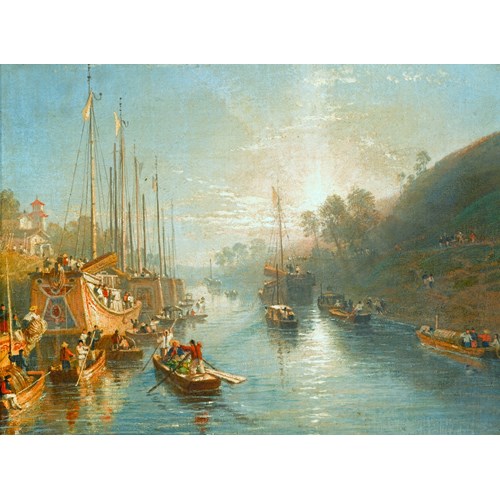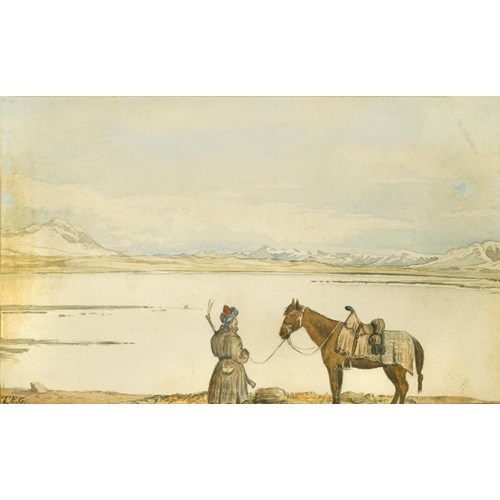Marketplace
The Proposal
Frank Stone
The Proposal
Period 1750-1850, 19th century
Origin England
Medium Oil on canvas
Dimension 88 x 113 cm (34⁵/₈ x 44¹/₂ inches)
With The Proposal, Frank Stone works with his favoured theme of courtship. The man is presenting a rose to the lady, who is looking up at him with a face of uncertainty, while a maid watches from the doorway. The scene is set in a Victorian interior and shows the influence of William Hogarth in its detailed depiction of an informal domestic scene, which includes; a wall-clock with a peacock feather lodged informally behind it, a shotgun mounted over the doorway, a top hat up-turned on the floor, a dog with a ball beside it, and a few prized books in a bookcase.
The image can be read as a sentimental picture of a romantic relationship set in a domestic family scene, with two young children reading at the table by the open window and a maid bringing refreshments. However, an alternative and more complex interpretation could suggest that the central women is in fact a widowed mother shown with her children, that the man is a suitor offering to marry her, and rather than a maid it is the widow’s anxious mother looking expectantly on the pair. The clock in the background is nearly at twelve, perhaps a reference to the foreboding eleventh hour. This interpretation could also explain the general casualness of the suitor, who is informally seated straddling a chair facing backwards, his hat and scarf carelessly strewn on the floor. The perspective of the image is also of note, as the eyes of the woman entering the room draw the viewer towards the couple, the dog appears to be looking at the viewer, further involving us in the scene. The dog could also be a symbol of the fidelity and loyalty of the suitor.
Stone was the son of a cotton-spinner, who took up painting in 1824. He settled in London in 1831 and was self-taught. His early work involved producing drawings for Charles Heath’s Books of Beauty (1833-47), but by 1833 he was exhibiting at the Old Watercolour Society. His initial entries at the British Institution in 1835 were genre subjects, while his first contributions to the Royal Academy in 1837 were portraits. Occasionally he treated literary themes, as in Scene from a Legend of Montrose (1840), Scene from Hamlet (1845) and Scene from The Tempest (1850-51). Stone was acquainted with many London artists and writers, some of whose portraits he painted, including William Thackeray and the poet Samuel Rogers. Stone was a close friend of Charles Dickens and often helped Dickens in his theatrical productions.
Stone’s watercolours and canvases proved popular because of their pretty sentimentality, whether of ‘keepsake’ ladies or of romantic and domestic themes. He usually painted only a single or a few figures in considerable detail, combining physical beauty with some degree of narrative content. Themes of courtship were recurrent in his work; his first success in this category was the Bashful Lover and the Maiden Coy (exhibited London, British Institution, 1842). This was followed by the Approaching Footstep (1845) and by a series of pictures beginning with Admonition (1842) at the Royal Academy. His best known achievements in this genre include the Last Appeal (1843), The Course of True Love Never Did Run Smooth (1844) and the Impending Mate and Mated (1847), some of these were engraved and gained favour with the public. Stone established a summer residence in Boulogne around 1853, and this change of scenery affected his subject matter to some degree. Scenes of flirtatious encounters and drawing-room vignettes gave way to such works as The Mussel-gatherer (1854), and fisherwomen replaced faint-hearted Victorian ladies in Stone’s repertory. However, in the last years of his life the artist sometimes returned to what the London Art Journal had called his ‘love-pictures’, as in Friendship Endangered (1858; private collection).
The image can be read as a sentimental picture of a romantic relationship set in a domestic family scene, with two young children reading at the table by the open window and a maid bringing refreshments. However, an alternative and more complex interpretation could suggest that the central women is in fact a widowed mother shown with her children, that the man is a suitor offering to marry her, and rather than a maid it is the widow’s anxious mother looking expectantly on the pair. The clock in the background is nearly at twelve, perhaps a reference to the foreboding eleventh hour. This interpretation could also explain the general casualness of the suitor, who is informally seated straddling a chair facing backwards, his hat and scarf carelessly strewn on the floor. The perspective of the image is also of note, as the eyes of the woman entering the room draw the viewer towards the couple, the dog appears to be looking at the viewer, further involving us in the scene. The dog could also be a symbol of the fidelity and loyalty of the suitor.
Stone was the son of a cotton-spinner, who took up painting in 1824. He settled in London in 1831 and was self-taught. His early work involved producing drawings for Charles Heath’s Books of Beauty (1833-47), but by 1833 he was exhibiting at the Old Watercolour Society. His initial entries at the British Institution in 1835 were genre subjects, while his first contributions to the Royal Academy in 1837 were portraits. Occasionally he treated literary themes, as in Scene from a Legend of Montrose (1840), Scene from Hamlet (1845) and Scene from The Tempest (1850-51). Stone was acquainted with many London artists and writers, some of whose portraits he painted, including William Thackeray and the poet Samuel Rogers. Stone was a close friend of Charles Dickens and often helped Dickens in his theatrical productions.
Stone’s watercolours and canvases proved popular because of their pretty sentimentality, whether of ‘keepsake’ ladies or of romantic and domestic themes. He usually painted only a single or a few figures in considerable detail, combining physical beauty with some degree of narrative content. Themes of courtship were recurrent in his work; his first success in this category was the Bashful Lover and the Maiden Coy (exhibited London, British Institution, 1842). This was followed by the Approaching Footstep (1845) and by a series of pictures beginning with Admonition (1842) at the Royal Academy. His best known achievements in this genre include the Last Appeal (1843), The Course of True Love Never Did Run Smooth (1844) and the Impending Mate and Mated (1847), some of these were engraved and gained favour with the public. Stone established a summer residence in Boulogne around 1853, and this change of scenery affected his subject matter to some degree. Scenes of flirtatious encounters and drawing-room vignettes gave way to such works as The Mussel-gatherer (1854), and fisherwomen replaced faint-hearted Victorian ladies in Stone’s repertory. However, in the last years of his life the artist sometimes returned to what the London Art Journal had called his ‘love-pictures’, as in Friendship Endangered (1858; private collection).
Period: 1750-1850, 19th century
Origin: England
Medium: Oil on canvas
Signature: Signed ‘Frank Stone’ (lower right).
Dimension: 88 x 113 cm (34⁵/₈ x 44¹/₂ inches)
More artworks from the Gallery









